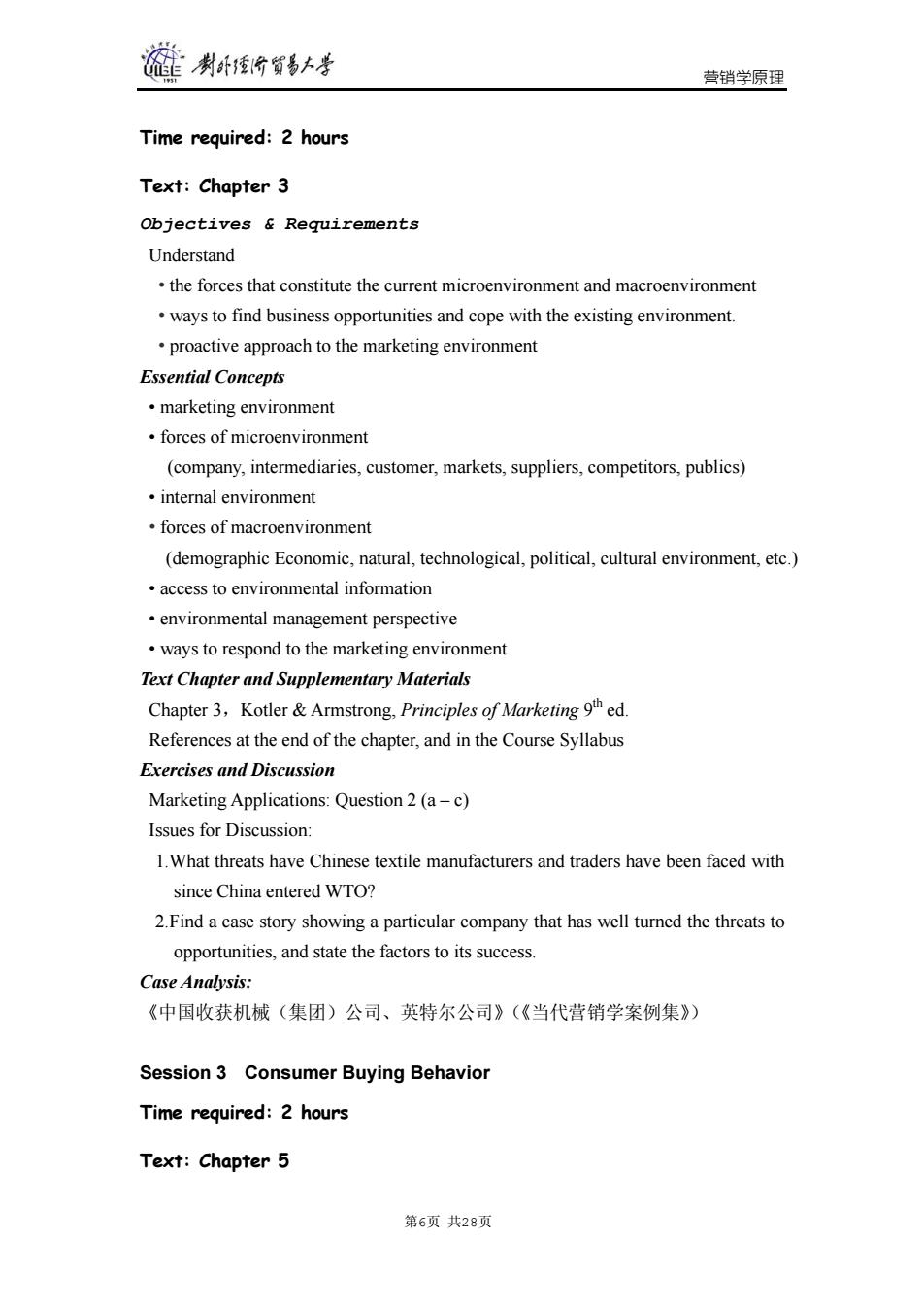
旌 制卧价贸易+学 营销学原理 Time required:2 hours Text:Chapter 3 Objectives Requirements Understand the forces that constitute the current microenvironment and macroenvironment ways to find business opportunities and cope with the existing environment. proactive approach to the marketing environment Essential Concepts marketing environment forces of microenvironment (company,intermediaries,customer,markets,suppliers,competitors,publics) internal environment forces of macroenvironment (demographic Economic,natural,technological,political,cultural environment,etc.) access to environmental information environmental management perspective ways to respond to the marketing environment Text Chapter and Supplementary Materials Chapter 3,Kotler&Armstrong,Principles of Marketinged. References at the end of the chapter,and in the Course Syllabus Exercises and Discussion Marketing Applications:Question 2 (a-c) Issues for Discussion: 1.What threats have Chinese textile manufacturers and traders have been faced with since China entered WTO? 2.Find a case story showing a particular company that has well turned the threats to opportunities,and state the factors to its success. Case Analysis: 《中国收获机械(集团)公司、英特尔公司》(《当代营销学案例集》) Session 3 Consumer Buying Behavior Time required:2 hours Text:Chapter 5 第6页共28页
营销学原理 Time required: 2 hours Text: Chapter 3 Objectives & Requirements Understand • the forces that constitute the current microenvironment and macroenvironment • ways to find business opportunities and cope with the existing environment. • proactive approach to the marketing environment Essential Concepts • marketing environment • forces of microenvironment (company, intermediaries, customer, markets, suppliers, competitors, publics) • internal environment • forces of macroenvironment (demographic Economic, natural, technological, political, cultural environment, etc.) • access to environmental information • environmental management perspective • ways to respond to the marketing environment Text Chapter and Supplementary Materials Chapter 3,Kotler & Armstrong, Principles of Marketing 9th ed. References at the end of the chapter, and in the Course Syllabus Exercises and Discussion Marketing Applications: Question 2 (a – c) Issues for Discussion: 1.What threats have Chinese textile manufacturers and traders have been faced with since China entered WTO? 2.Find a case story showing a particular company that has well turned the threats to opportunities, and state the factors to its success. Case Analysis: 《中国收获机械(集团)公司、英特尔公司》(《当代营销学案例集》) Session 3 Consumer Buying Behavior Time required: 2 hours Text: Chapter 5 第6页 共28页
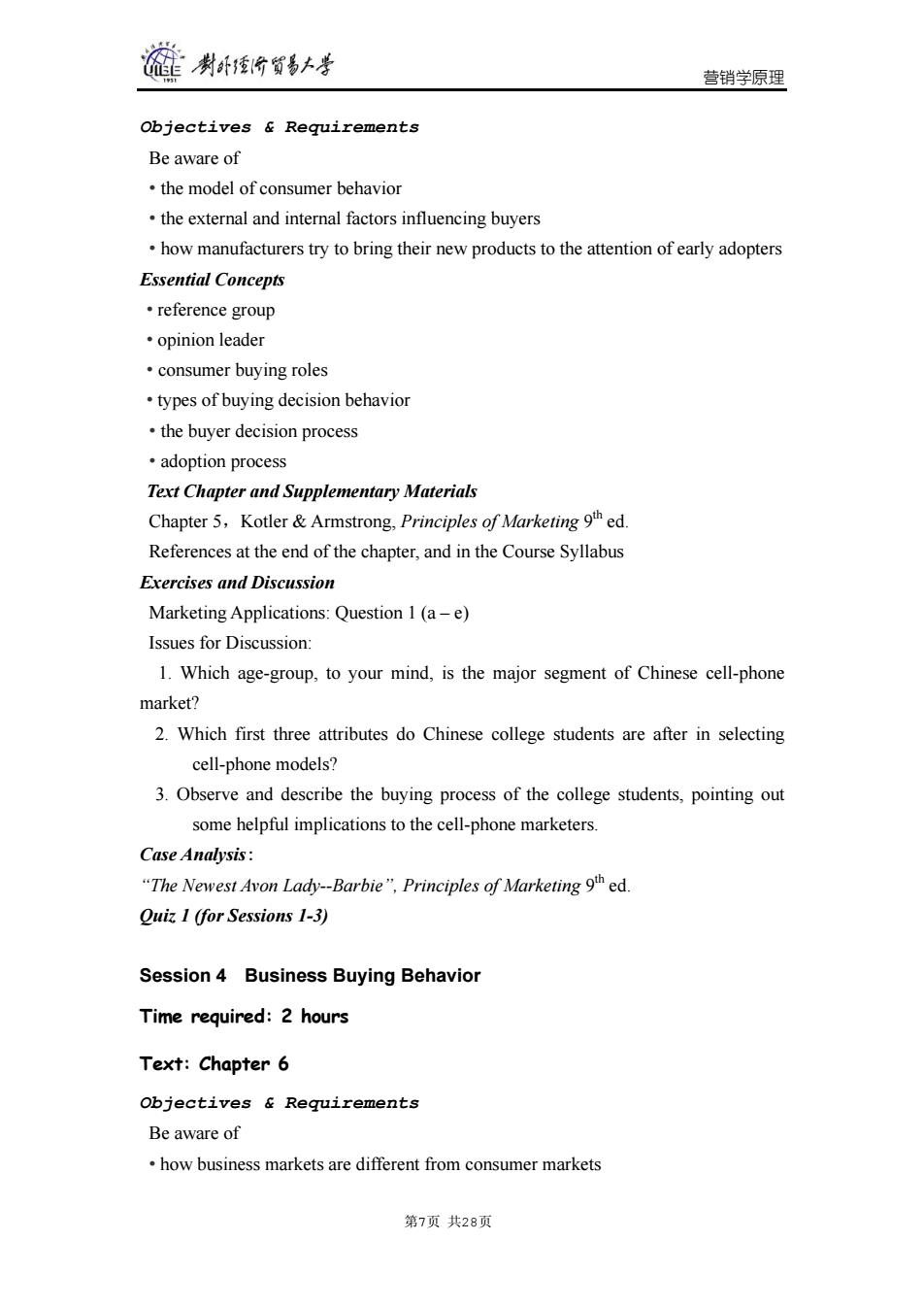
制卧价贸易+学 营销学原理 Objectives Requirements Be aware of the model of consumer behavior the external and internal factors influencing buyers how manufacturers try to bring their new products to the attention of early adopters Essential Concepts ·reference group ·opinion leader consumer buying roles types of buying decision behavior the buyer decision process ·adoption process Text Chapter and Supplementary Materials Chapter 5,Kotler Armstrong,Principles of Marketing 9th ed. References at the end of the chapter,and in the Course Syllabus Exercises and Discussion Marketing Applications:Question 1 (a-e) Issues for Discussion: 1.Which age-group,to your mind,is the major segment of Chinese cell-phone market? 2.Which first three attributes do Chinese college students are after in selecting cell-phone models? 3.Observe and describe the buying process of the college students,pointing out some helpful implications to the cell-phone marketers. Case Analysis: "The Newest Avon Lady--Barbie"Principles of Marketing 9ed. Quiz 1 (for Sessions 1-3) Session 4 Business Buying Behavior Time required:2 hours Text:Chapter 6 Objectives Requirements Be aware of how business markets are different from consumer markets 第7页共28页
营销学原理 Objectives & Requirements Be aware of • the model of consumer behavior • the external and internal factors influencing buyers • how manufacturers try to bring their new products to the attention of early adopters Essential Concepts • reference group • opinion leader • consumer buying roles • types of buying decision behavior • the buyer decision process • adoption process Text Chapter and Supplementary Materials Chapter 5,Kotler & Armstrong, Principles of Marketing 9th ed. References at the end of the chapter, and in the Course Syllabus Exercises and Discussion Marketing Applications: Question 1 (a – e) Issues for Discussion: 1. Which age-group, to your mind, is the major segment of Chinese cell-phone market? 2. Which first three attributes do Chinese college students are after in selecting cell-phone models? 3. Observe and describe the buying process of the college students, pointing out some helpful implications to the cell-phone marketers. Case Analysis: “The Newest Avon Lady--Barbie”, Principles of Marketing 9th ed. Quiz 1 (for Sessions 1-3) Session 4 Business Buying Behavior Time required: 2 hours Text: Chapter 6 Objectives & Requirements Be aware of • how business markets are different from consumer markets 第7页 共28页
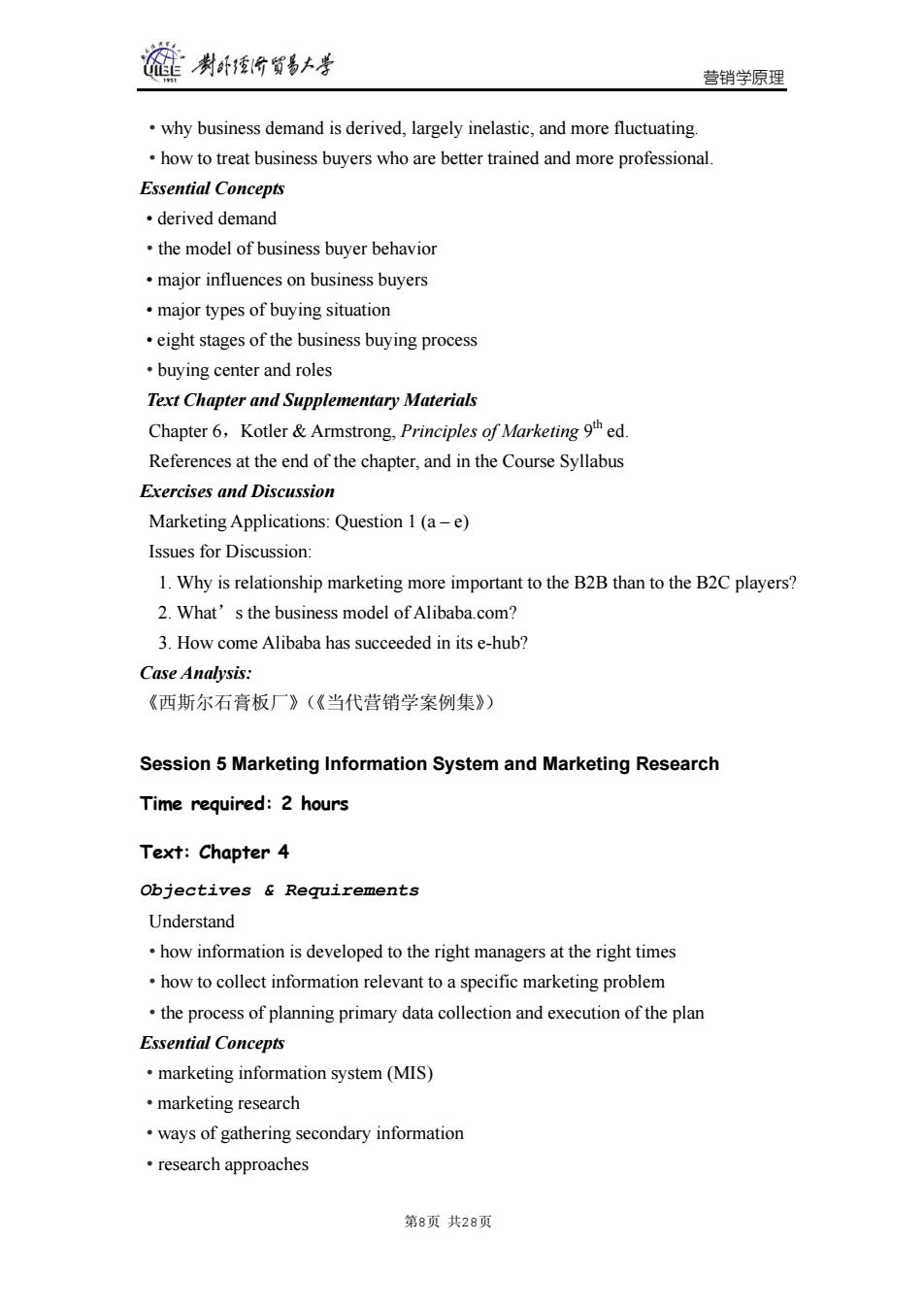
制卧爱分贸易+学 营销学原理 why business demand is derived,largely inelastic,and more fluctuating. how to treat business buyers who are better trained and more professional Essential Concepts ·derived demand the model of business buyer behavior major influences on business buyers major types of buying situation eight stages of the business buying process buying center and roles Text Chapter and Supplementary Materials Chapter6,Kotler&Armstrong,Principles of Marketinged. References at the end of the chapter,and in the Course Syllabus Exercises and Discussion Marketing Applications:Question 1(a-e) Issues for Discussion: 1.Why is relationship marketing more important to the B2B than to the B2C players? 2.What's the business model of Alibaba.com? 3.How come Alibaba has succeeded in its e-hub? Case Analysis: 《西斯尔石膏板厂》(《当代营销学案例集》) Session 5 Marketing Information System and Marketing Research Time required:2 hours Text:Chapter 4 Objectives Requirements Understand how information is developed to the right managers at the right times how to collect information relevant to a specific marketing problem the process of planning primary data collection and execution of the plan Essential Concepts marketing information system (MIS) ·marketing research ways of gathering secondary information ·research approaches 第8页共28页
营销学原理 • why business demand is derived, largely inelastic, and more fluctuating. • how to treat business buyers who are better trained and more professional. Essential Concepts • derived demand • the model of business buyer behavior • major influences on business buyers • major types of buying situation • eight stages of the business buying process • buying center and roles Text Chapter and Supplementary Materials Chapter 6,Kotler & Armstrong, Principles of Marketing 9th ed. References at the end of the chapter, and in the Course Syllabus Exercises and Discussion Marketing Applications: Question 1 (a – e) Issues for Discussion: 1. Why is relationship marketing more important to the B2B than to the B2C players? 2. What’s the business model of Alibaba.com? 3. How come Alibaba has succeeded in its e-hub? Case Analysis: 《西斯尔石膏板厂》(《当代营销学案例集》) Session 5 Marketing Information System and Marketing Research Time required: 2 hours Text: Chapter 4 Objectives & Requirements Understand • how information is developed to the right managers at the right times • how to collect information relevant to a specific marketing problem • the process of planning primary data collection and execution of the plan Essential Concepts • marketing information system (MIS) • marketing research • ways of gathering secondary information • research approaches 第8页 共28页
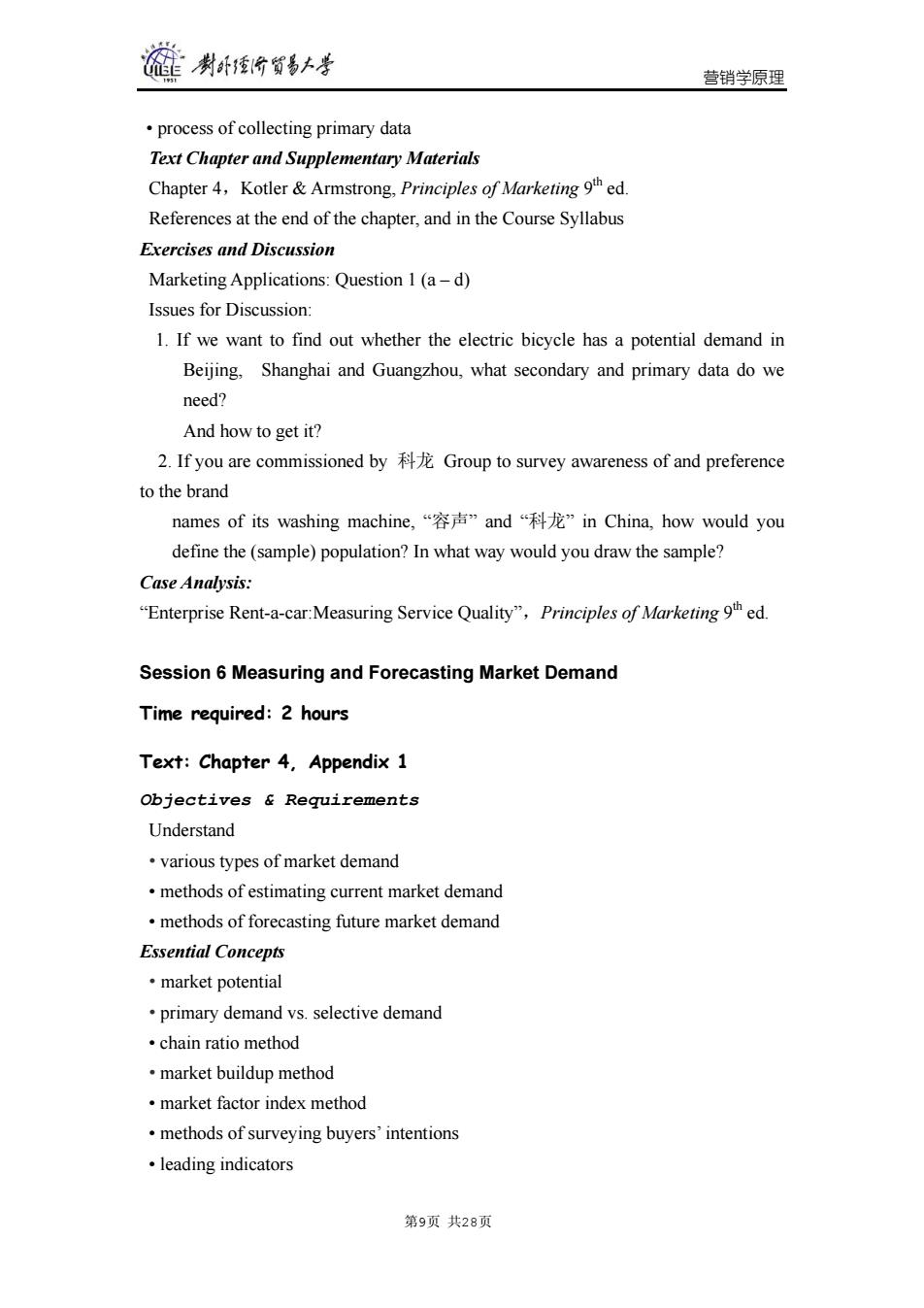
莲 制卧价贸易+学 营销学原理 process of collecting primary data Text Chapter and Supplementary Materials Chapter 4,Kotler&Armstrong,Principles of Marketing ed. References at the end of the chapter,and in the Course Syllabus Exercises and Discussion Marketing Applications:Question 1 (a-d) Issues for Discussion: 1.If we want to find out whether the electric bicycle has a potential demand in Beijing,Shanghai and Guangzhou,what secondary and primary data do we need? And how to get it? 2.If you are commissioned by Group to survey awareness of and preference to the brand names of its washing machine,“容声”and“科龙”in China,how would you define the (sample)population?In what way would you draw the sample? Case Analysis: "Enterprise Rent-a-car:Measuring Service Quality",Principles of Marketing 9th ed. Session 6 Measuring and Forecasting Market Demand Time required:2 hours Text:Chapter 4,Appendix 1 Objectives Requirements Understand various types of market demand methods of estimating current market demand methods of forecasting future market demand Essential Concepts ·market potential primary demand vs.selective demand ·chain ratio method market buildup method market factor index method methods of surveying buyers'intentions ·leading indicators 第9页共28页
营销学原理 • process of collecting primary data Text Chapter and Supplementary Materials Chapter 4,Kotler & Armstrong, Principles of Marketing 9th ed. References at the end of the chapter, and in the Course Syllabus Exercises and Discussion Marketing Applications: Question 1 (a – d) Issues for Discussion: 1. If we want to find out whether the electric bicycle has a potential demand in Beijing, Shanghai and Guangzhou, what secondary and primary data do we need? And how to get it? 2. If you are commissioned by 科龙 Group to survey awareness of and preference to the brand names of its washing machine, “容声” and “科龙” in China, how would you define the (sample) population? In what way would you draw the sample? Case Analysis: “Enterprise Rent-a-car:Measuring Service Quality”,Principles of Marketing 9th ed. Session 6 Measuring and Forecasting Market Demand Time required: 2 hours Text: Chapter 4, Appendix 1 Objectives & Requirements Understand • various types of market demand • methods of estimating current market demand • methods of forecasting future market demand Essential Concepts • market potential • primary demand vs. selective demand • chain ratio method • market buildup method • market factor index method • methods of surveying buyers’ intentions • leading indicators 第9页 共28页
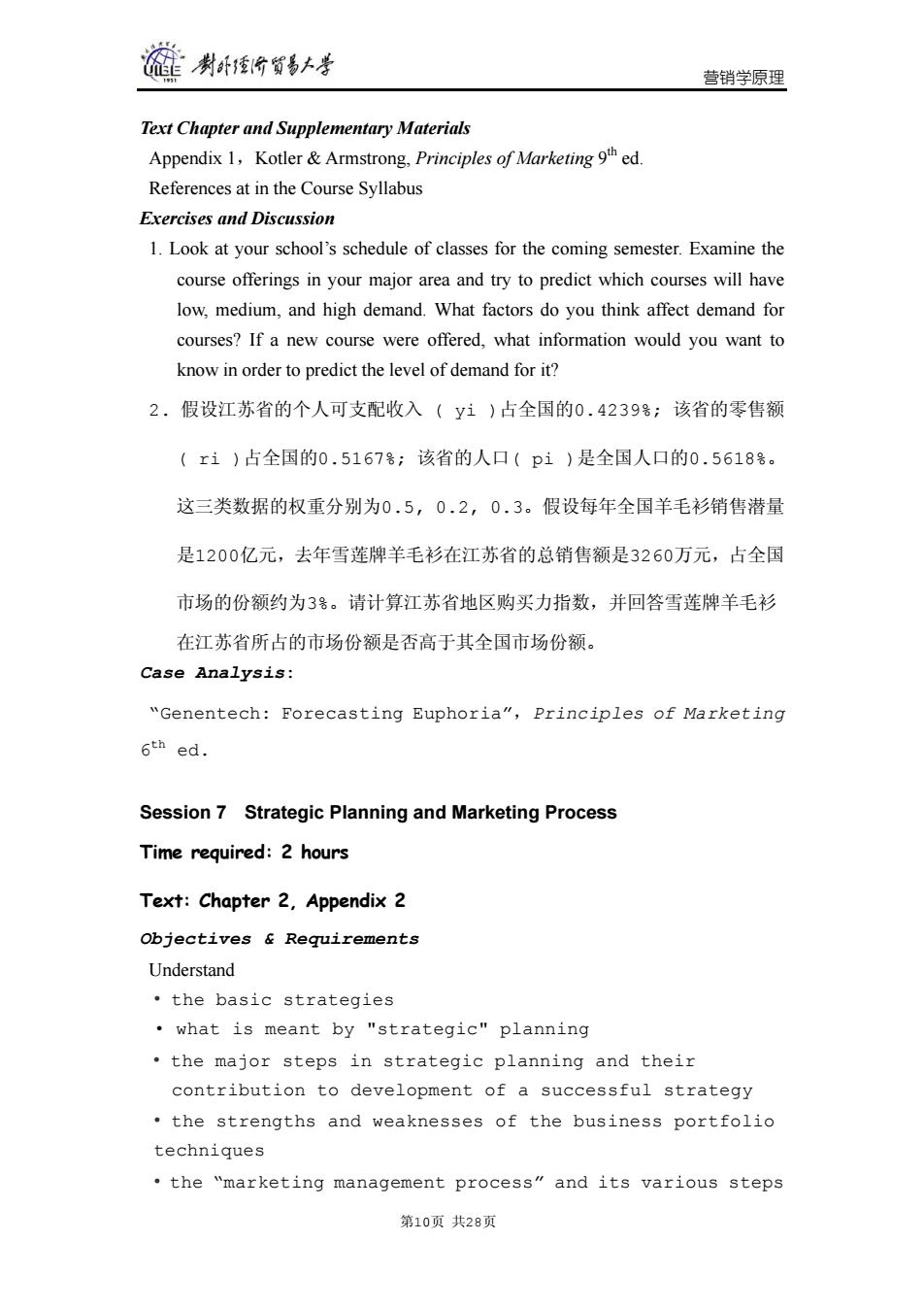
溢 制卧台贸易上考 营销学原理 Text Chapter and Supplementary Materials Appendix 1,Kotler Armstrong,Principles of Marketing 9th ed. References at in the Course Syllabus Exercises and Discussion 1.Look at your school's schedule of classes for the coming semester.Examine the course offerings in your major area and try to predict which courses will have low,medium,and high demand.What factors do you think affect demand for courses?If a new course were offered,what information would you want to know in order to predict the level of demand for it? 2.假设江苏省的个人可支配收入(yi)占全国的0.4239号;该省的零售额 (ri)占全国的0.5167号;该省的人口(pi)是全国人口的0.5618号。 这三类数据的权重分别为0.5,0.2,0.3。假设每年全国羊毛衫销售潜量 是1200亿元,去年雪莲牌羊毛衫在江苏省的总销售额是3260万元,占全国 市场的份额约为3号。请计算江苏省地区购买力指数,并回答雪莲牌羊毛衫 在江苏省所占的市场份额是否高于其全国市场份额。 Case Analysis: "Genentech:Forecasting Euphoria",Principles of Marketing 6th ed. Session 7 Strategic Planning and Marketing Process Time required:2 hours Text:Chapter 2,Appendix 2 Objectives Requirements Understand ·the basic strategies what is meant by "strategic"planning the major steps in strategic planning and their contribution to development of a successful strategy the strengths and weaknesses of the business portfolio techniques the "marketing management process"and its various steps 第10页共28页
营销学原理 Text Chapter and Supplementary Materials Appendix 1,Kotler & Armstrong, Principles of Marketing 9th ed. References at in the Course Syllabus Exercises and Discussion 1. Look at your school’s schedule of classes for the coming semester. Examine the course offerings in your major area and try to predict which courses will have low, medium, and high demand. What factors do you think affect demand for courses? If a new course were offered, what information would you want to know in order to predict the level of demand for it? 2. 假设江苏省的个人可支配收入 ( yi )占全国的0.4239%; 该省的零售额 ( ri )占全国的0.5167%; 该省的人口( pi )是全国人口的0.5618%。 这三类数据的权重分别为0.5, 0.2, 0.3。假设每年全国羊毛衫销售潜量 是1200亿元,去年雪莲牌羊毛衫在江苏省的总销售额是3260万元,占全国 市场的份额约为3%。请计算江苏省地区购买力指数,并回答雪莲牌羊毛衫 在江苏省所占的市场份额是否高于其全国市场份额。 Case Analysis: “Genentech: Forecasting Euphoria”,Principles of Marketing 6th ed. Session 7 Strategic Planning and Marketing Process Time required: 2 hours Text: Chapter 2, Appendix 2 Objectives & Requirements Understand • the basic strategies • what is meant by "strategic" planning • the major steps in strategic planning and their contribution to development of a successful strategy • the strengths and weaknesses of the business portfolio techniques • the “marketing management process” and its various steps 第10页 共28页